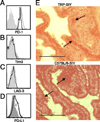Differential requirement for CD70 and CD80/CD86 in dendritic cell-mediated activation of tumor-tolerized CD8 T cells
- PMID: 22798683
- PMCID: PMC4060810
- DOI: 10.4049/jimmunol.1201271
Differential requirement for CD70 and CD80/CD86 in dendritic cell-mediated activation of tumor-tolerized CD8 T cells
Abstract
A major obstacle to efficacious T cell-based cancer immunotherapy is the tolerizing-tumor microenvironment that rapidly inactivates tumor-infiltrating lymphocytes. In an autochthonous model of prostate cancer, we have previously shown that intratumoral injection of Ag-loaded dendritic cells (DCs) delays T cell tolerance induction as well as refunctionalizes already tolerized T cells in the tumor tissue. In this study, we have defined molecular interactions that mediate the effects of DCs. We show that pretreating Ag-loaded DCs with anti-CD70 Ab abolishes the ability of DCs to delay tumor-mediated T cell tolerance induction, whereas interfering with 4-1BBL, CD80, CD86, or both CD80 and CD86 had no significant effect. In contrast, CD80(-/-) or CD80(-/-)CD86(-/-) DCs failed to reactivate already tolerized T cells in the tumor tissue, whereas interfering with CD70 and 4-1BBL had no effect. Furthermore, despite a high level of programmed death 1 expression by tumor-infiltrating T cells and programmed death ligand 1 expression in the prostate, disrupting programmed death 1/programmed death ligand 1 interaction did not enhance T cell function in this model. These findings reveal dynamic requirements for costimulatory signals to overcome tumor-induced tolerance and have significant implications for developing more effective cancer immunotherapies.
Figures






References
-
- Fife BT, Bluestone JA. Control of peripheral T-cell tolerance and autoimmunity via the CTLA-4 and PD-1 pathways. Immunol Rev. 2008;224:166–182. - PubMed
Publication types
MeSH terms
Substances
Grants and funding
LinkOut - more resources
Full Text Sources
Other Literature Sources
Molecular Biology Databases
Research Materials

